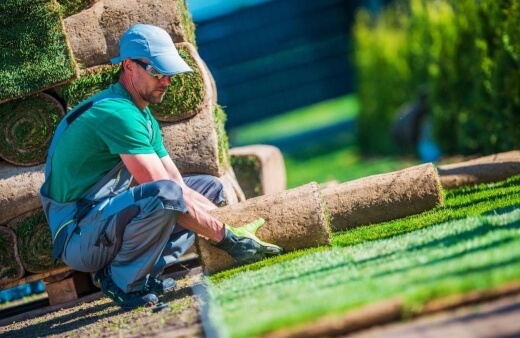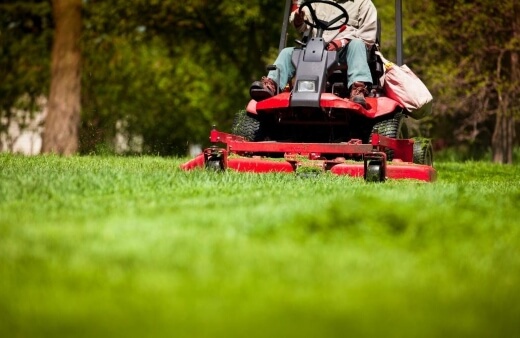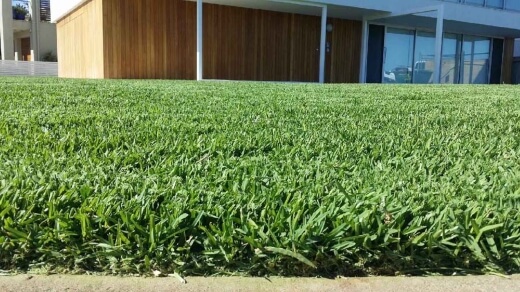Sir Walter is Australia’s number one buffalo turf variety due to the fact it provides growers and homeowners with a superior soft, luscious and vibrant-green grass alternative with hard-wearing qualities that will impress and look fantastic year-round.
The soft leaf blades will provide comfort underfoot and the deep root systems will ward off weeds in the garden and provide less leaf water loss versus other turf varieties.
This grass is perfect for homes with children and pets as it is non-toxic and very safe to use. Being tolerant to shade, drought and cold once established, this native grass can be grown anywhere in the garden and can add a long-lasting luscious touch to any landscape or green space.
More...
Introducing Sir Walter Buffalo Grass

Source: ancoturf.com.au
DNA Certified Sir Walter Buffalo grass was cultivated as a tough turf for the harsh Australian climates in the 1990s. Requiring less water and less maintenance than its competition, this grass stands out thanks to its resilience and soft texture.
Being a native lawn alternative, Sir Walter Buffalo grass will look good throughout the year and is accessible to all growers regardless of skill level. This grass grows best in warm climates with healthy rainfall and plenty of sunlight.
It is the dense and fast-growing nature that has popularised this turf across the country, along with the fact that it is easy-going and won’t be a hassle to maintain. The optimal growing height is around 20 to 25 centimetres for use as a lawn substitute.
Key Benefits of using Sir Walter Buffalo Turf
- National Popularity – Developed to thrive anywhere in Australia’s diverse climate, this grass can grow well in full sun or shade and can survive extreme conditions like heat waves, drought or frost. It is also very tolerant of salt.
- Year-Round Easy-Care & Good Looks – This grass is popular for its low-maintenance nature and resistance to humidity, fungi and pests. It will also look healthy and attractive throughout the year with little hassle as it is known to retain more vivid colour than other alternatives.
- Repels Weeds – This turf grows tight and dense so it will ward off weeds which means even less maintenance for you. It offers a superior soft feel without any nasty prickles meaning you and your family can enjoy this grass with bare feet, anytime.
- Very Resistant to Disease & Pests – This turf was developed to have strong immunity to insect infestations or fungal diseases which means you won’t have to depend on chemicals for healthy turf. This turf is, therefore, more environmentally friendly than other grasses and can save you money and time.
- Prevents Allergies – Sir Walter Buffalo grass is ideal for those who are prone to allergies as it produces little to no allergens. It is also safe for pets and children.
- Self-Repairing – This tough turf can survive wear and tear from animals, foot traffic and other damaging elements. It can quickly recover from damage meaning you can easily maintain a clean and attractive lawn year-round.
- Attractive – This turf features luscious, broad dark-green leaves with a horizontal growth habit.
How to Grow Sir Walter Buffalo

Source: turfco.com.au
It is not recommended to grow this turf using seeds or to buy seeds as Sir Walter Buffalo grass produces male, sterile seeds. This grass is best bought as an instant lawn from reputable and accredited turf suppliers.
Once you receive your Sir Walter Buffalo grass, it will already be partially grown where you would just need to lay it and establish it in your landscape.
Once established, you will be rewarded with a low-maintenance lawn that is tolerant to weeds, drought, shade, and even cold weather. Generally, this grass takes between 4 to 6 weeks to develop strong roots and establish itself in gardens once laid.
Certain variations in light or foot traffic can slow the growing process down but this grass is hardy and can easily bounce back from any damage. The peak growing season is between summer and autumn.
Planting Sir Walter Buffalo
This turf is mostly used as residential grass for front and back yards where it can thrive in many different environments across the country.
It is recommended to plant and establish Sir Walter Buffalo lawn in your garden during spring but in warmer areas, this turf can generally be laid at any time of the year other than winter.


Get Your Free Guide:
Master Growing Australian Natives eBook
A Must Have Complete Guide for Every Australian Garden
Get Your Free Guide:
Master Growing Australian Natives eBook
A Must Have Complete Guide for Every Australian Garden

Sir Walter Turf Sun Requirement
This grass will grow best in full sun to part shade. It is recommended that it receives at least 4 hours of healthy sunlight per day, especially in the developing stages. However, Sir Walter Buffalo grass can withstand more shaded areas as well.
Soil Preparation
Sir Walter Turf will grow best in soil that is loose and rich in nutrients. Sandy soil types should work great. Before installing the turf, you can add a fresh soil and compost mixture to your existing ground to help with enriching the area if needed.
Rake and level the soil mixture to be about 40mm lower than your desired lawn height. Be sure to prepare enough soil to allow the deep roots of the grass to establish. Soil pH levels of 6 to 7 are ideal for this turf.
Check out our in-depth, step by step guide on how to install turf in your garden.
Sir Walter Buffalo Care
Establishing the grass in your landscape will take a little more effort but it will be well worth it once you have a lifelong, luscious lawn that is self-sustainable in many ways. Once established, this turf will be tolerant to drought, moisture and cold weather conditions.
This grass is known to bounce back from damage quickly and won’t require the use of pesticides or fungicides due to its natural impervious nature towards insect infestations and fungal infections.
Here is how to care for your Sir Walter Buffalo grass.
Watering Sir Walter Buffalo Grass
Once you have laid your grass, keep it moist for the first two to three weeks and try to avoid letting it dry out. This will help the roots establish themselves in the soil.
Like with most lawns, watering in the morning or mid-afternoon is best. After these initial weeks, the grass will need deeper but less-frequent waterings. Check out our buying guide for the best retractable hose reels to help make your watering task easier.
Once established, water well once per fortnight during the summer months. In spring and autumn, you can water the grass about once per month. Cut back all watering during the winter months.
Fertilising Sir Walter Buffalo
You can consider fertilising your lawn after at least 6 weeks of growth in your landscape. You can fertilise quarterly to help establish the grass then every 8 weeks or so once the grass is fully developed.
You will know the turf needs a boost if you notice the grass fading or becoming pale. It is recommended to use a slow-release fertiliser in late autumn to strengthen the turf for the winter months.
Always water your grass well after fertilising, especially in the hotter months when growth is naturally accelerated. It is important to use a fertiliser that won’t damage your lawn.
Be sure to chat to the professional suppliers of this grass in your area if you are concerned about using the right fertiliser. Sir Walter Buffalo grass generally thrives when using a fertiliser high in iron.
Mowing Sir Walter Buffalo

Once the roots have developed, the leaves have grown and are roughly 6 centimetres in height, you can start mowing your lawn. (See our review on the best electric lawn mowers to help you with this task.)
Always be sure to follow the one-third rule where you only mow away one-third of the grass height each time. In the faster growing seasons of autumn and summer, you can mow the Sir Walter Buffalo grass once per week or as needed.
You may need to dethatch your grass annually. To do this, scalp the grass by mowing it short. Fertilise and water well afterwards to promote healthy, dense new growth.
If you need to remove any weeds that may have grown, this is best done before winter.
Sir Walter Turf Pests, Problems & Diseases
As mentioned, this turf is very resistant to attacks from insects or fungal diseases. However, there may be other smaller issues you might notice and want to take care of.
Overall, Sir Walter Buffalo grass is tough and was specifically developed to withstand Australian environments and conditions.
Uneven Grass Growth
If you notice the grass is growing better at spots where there are nearby water sources like taps or other sources underneath the soil, this may indicate that you need to water your lawn more frequently.
Winter Blues
Preparation for winter is important to give your grass the best shot at staying healthy throughout those cold months. Adding a slow-release fertiliser in late autumn along with a good watering can help avoid the lawn from suffering and getting damaged during the winter period.

Source: instantlawnadelaidesa.com.au
Soil Considerations
This turf will need at least 100mm of good quality soil beneath it to grow best. You can consider adding a top layer of soil to the grass to help stabilise it and level out your terrain.
Adding a layer of topsoil can also give your grass a nutrient boost and improve the drainage of the ground.
Bare Patches
Sometimes high traffic or animal urine can cause bare patches on your lawn. You can fill these areas by either adding new turf and trying to get that established or you can add fresh topsoil and fertiliser to the area to try to encourage new growth.
Sir Walter Buffalo Grass FAQs
Is buffalo grass the same as Sir Walter?
Yes. DNA Certified Sir Walter is an Australian-bred, soft-leaf Buffalo Grass.
Is Sir Walter buffalo grass invasive?
Along with other excellent qualities, this grass is also a non-invasive turf variety.
When should I Dethatch my buffalo lawn Australia?
Dethatching is best done between October and December. Scalp the lawn almost to the roots then revitalise the grass by adding a good lawn food fertiliser and water well.
For more options and information, be sure to see our other helpful guides:
Plan Your New Landscape with Sir Walter Buffalo
A hardy, very low-maintenance native turf that can provide yearlong lusciousness for a spotless looking lawn, Sir Walter Buffalo grass is the perfect fit for any Australian garden.
If you are planning your new landscape or are looking for the best grass substitute for your lawn in Australia, Sir Walter Buffalo is just for you.

Published on April 3, 2022 by Nathan Schwartz
Last Updated on September 26, 2025




